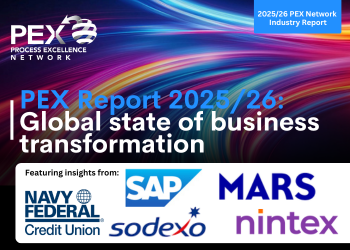5 ways process mining lives on
Process mining continues to thrive in the AI-driven era of process intelligence
Add bookmark
The artificial intelligence (AI) driven era of process intelligence is well underway, but process mining lives on!
Process mining has been an integral component of process excellence for years. More recently, process intelligence has emerged as the latest buzz term of prominence – offering greater capabilities and qualities for enhancing process optimization.
When you throw increasingly sophisticated AI – such as generative AI and agentic AI – into the equation, it’s little wonder why many people are not only clamoring over the transformative potential of process intelligence but also questioning whether the more traditional approach of process mining still holds value (or even being replaced).
Join the PEX Network community

Don't miss any news, updates or insider tips from PEX Network by getting them delivered to your inbox. Sign up to our newsletter and join our community of experts.
Learn MoreProcess mining versus process intelligence
First, let’s establish the difference between process mining and process intelligence.
Process mining focuses on analyzing event logs from IT systems like enterprise resource planning (ERP) and customer relationship management (CRM) to discover, monitor and improve business processes.
Process intelligence is a broader discipline that goes beyond process mining by applying AI and machine learning analytics, business intelligence and real-time monitoring. It provides ongoing insights into business operations by combining process mining with predictive and prescriptive analytics.
Process mining can be used to support process discovery, conformance checking and performance analysis, but typically lacks real-time monitoring, predictive insights and prescriptive insights – things that process intelligence excels at.
Join us at All Access: BPM Business Process Management 2025 and learn how to identify and improve key processes!
5 reasons why process mining lives on
1. Process mining isn’t being replaced
The misconception that process mining is being replaced is flat-out wrong, says Vinod Goje, data-driven solutions and applied AI expert. “In reality, it’s being integrated with AI, automation and real-time analytics to unlock next-level visibility and actionability. If you're in finance, healthcare, manufacturing or logistics, you’re already seeing it in fraud detection, patient pathway optimization, supply chain de-bottlenecking and delivery performance.”
2. Becoming more powerful
In this regard, process mining is evolving into something more powerful, adds Goje. “While process intelligence is the new buzzword, what’s getting lost is that process mining remains the bedrock of operational clarity. It’s still the fastest way to see how your business actually runs, not how your process owners ‘think’ it runs. That’s not just useful; it’s non-negotiable for any serious digital transformation effort.”
3. Tackling process debt
Emerging technology like AI agents is excellent at helping to automate processes and make integrations come to life – dynamically and responsively to agile requirements, but it comes at a cost – so called “process debt,” says J-M Erlendson, chief evangelist and business process expert at ARIS. This is where core systems are accessed in increasingly different ways, with transactions coming from many places and under different process scenarios, all with minimal documentation, visibility and ability-to-analyze.
“In that world, process mining has become the ‘wise shepherd,’ rounding up the ‘chaos sheep’ of disparate processes spurred by tech innovation and sprawl,” Erlendson adds. “It uncovers where and how transactions are being activated and how this affects the performance of key processes.”
Process mining provides visibility to decision-makers to help them understand which processes and technologies are working well and provides suggestions (and future-proofing) on how to improve to meet KPIs. “It blueprints your ACTUAL process, revealing your misconceptions and giving you a lever to affect meaningful change through process re-engineering, standardization and automation/practice change,” says J-M.
4. Harnessing process data and responsible AI adoption
While organizations have long had access to vast amounts of sales, security and financial data to analyze and improve operations, they’ve lacked effective tools to harness process data, says Jon Knisley, process AI strategy and operations leader at ABBYY. “This gap in operational visibility has been the missing puzzle piece preventing companies from fully delivering on the promise of data-driven decision-making.”
Process mining continues to bridge this critical gap, addressing the void created by limited insight into operational workflows. As a result, it remains an indispensable component of the modern tech stack. “Even as companies pivot toward AI-first strategies and embrace agentic automation, process mining will continue to play a vital role. It serves as both the foundation and ongoing guide for effective and responsible AI adoption.”
5. Process intelligence needs process mining
Process mining and process intelligence are not mutually exclusive; in fact, process intelligence cannot occur without process mining first, says Jimmie Lee, founder and CEO at JLEE & Associates.
Wil van der Aalst, renowned globally as the “godfather of process mining” and chief scientist at Celonis, concurs. “Note that process mining is the main component of process intelligence. I define process intelligence as object-centric process mining (OCPM) plus AI. OCPM provides the context that AI needs to do something relevant.”
In other words, without process mining, process intelligence would be a theoretical exercise, a paper tiger, adds Caspar Jans, director Celonis process management. “With process mining, you add the reality to your process intelligence and provide the right context for AI to be incredibly powerful.”
Process mining holds immense value, yet it often goes by a different name: data discovery, adds Lee. “Thus, it is often the foundation and core principle of business, strategy and digital transformation. Process mining is not dead, it just evolved!
Register for All Access: Revolution in Process Intelligence APAC 2025!
A new era for process mining tools
Ultimately, process mining isn’t dead, but the era of process mining as a silver bullet is over, says Alexandre Wentzo, CEO at iGrafx. “It’s still a critical capability, especially for uncovering how processes actually run across systems, but by itself, process mining provides only a system-centric view – often missing manual work, policy exceptions and the broader context of how processes operate across departments.”
Where process mining shines is as an enabler of process intelligence – bringing valuable data into ‘living’ models that can be analyzed, simulated and optimized in real-time. “For true transformation, organizations need to move beyond isolated process mining to a more integrated approach that combines modeling, monitoring and continuous improvement. The future isn’t about process mining or process modeling – it’s about bringing them together into a cohesive, intelligent view of the business.”
PEX Report 2025/26: Global state of business transformation

The PEX Report 2025/26 examines the results of our annual survey of more than 200 professionals with insights from more than a dozen industry business and thought leaders from across the globe. Contributors include leaders from Mars, Navy Federal Credit Union, Pacific International Lines, Sodexo, SAP and Nintex!
Explore why true business transformation is not a singular project but an ongoing journey, one that requires visionary leadership, cross-functional collaboration, technological prowess and an unrelenting commitment to agility and innovation. Those that embrace this evolution holistically are not just surviving the future, they are shaping it!
Download Now












